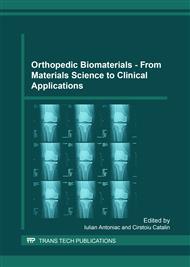[1]
J. Charnley, The bonding of prostheses to bone by cement, J Bone Joint Surg Br 46 (1964) 518-529.
DOI: 10.1302/0301-620x.46b3.518
Google Scholar
[2]
M. C. Rusu, C. Ibanescu, I. C. Ichim, G. Riess, M. Popa, D. Rusu, M. Rusu, Radiopaque acrylic one cements with bromine containing monomer, J. Appl. Polymer Sci. 111(2009) 2493-2506.
DOI: 10.1002/app.29253
Google Scholar
[3]
G. Lewis, Alternative acrylic bone cement formulations for cemented arthroplasties: present status, key issues, and future prospects, J. Biomed. Mater. Res. B: Appl. Biomater. 84 (2008) 301-319.
DOI: 10.1002/jbm.b.30873
Google Scholar
[4]
H. Reza Seyyed Hosseinzadeh, M. Emami, F. Lahiji, A. S. Shahi, A. Masoudi, S. Emami, The Acrylic Bone Cement in Arthroplasty, in: Orthopedics, Physical Medicine and Rehabilitation, Edited by Plamen Kinov (2013)101-130.
DOI: 10.5772/53252
Google Scholar
[5]
Po‑L. Lai, L‑H Chen, W‑J Chen, I‑M Chu, Chemical and physical properties of bone cement for vertebroplasty, Biomed. J. 36 (2013): 162-167.
DOI: 10.4103/2319-4170.112750
Google Scholar
[6]
J. C. J. Webb, R. F. Spencer, The role of polymethylmethacrylate bone cement in modern orthopaedic surgery, J. Bone Joint Surg. [Br] 89(2007): 851-7.
DOI: 10.1302/0301-620x.89b7.19148
Google Scholar
[7]
A. F. Boeckler, D. Morton, S. Poser, K.E. Dette, Release of dibenzoyl peroxide from polymethyl methacrylate denture base resins: An in vitro evaluation, Dent. Mater. 24( 2008)1602-1607.
DOI: 10.1016/j.dental.2008.03.019
Google Scholar
[8]
N. Silikas, G. Eliades, D. Watts, Light intensity effects on resin-composite degree of conversion and shrinkage strain, Dent. Mater. 16(2000) 292-296.
DOI: 10.1016/s0109-5641(00)00020-8
Google Scholar
[9]
C. P. Hagan, J. F. Orr, C. A. Mitchell, N. J. Dunne, Real time monitoring of the polymerization of PMMA bone cement using Raman Spectroscopy, J. Mater. Sci: Mater Med. 20(2009) 2427-2431.
DOI: 10.1007/s10856-009-3822-1
Google Scholar
[10]
S. Cavalu, V. Simon, Microstructure and bioactivity of acrylic bone cements for prosthetic surgery, JOAM 8/ 4( 2006) 1520 – 1523.
Google Scholar
[11]
K. -D. Kuehn, Acrylic bone cements: mechanical and physicalproperties, Orthop. Clin . Am. 36(2005) 29-39.
Google Scholar
[12]
M. J. Provenzano, K. P.J. Murphy, L. H. Riley, Bone cements: Review of their physic-chemical and biochemical properties in percutaneous vertebroplasty, Am. J. Neuroradiol 25 (2004) 1286-1290.
Google Scholar
[13]
S. Cavalu, S. Cîntă Pînzaru, N. Peica, G. Damian, W. Kiefer, Adsorption behavior of hyaluronidase onto silver nanoparticles and PMMA bone substitute, J. Optoelectronics and Advanced Materials, Vol. 9(3) (2007) 689-693.
Google Scholar
[14]
S. I. Salih, J. K. Oleiwi, Q. A. Hamad, Investigation of fatigue and compression strength for the PMMA reinforced by different system for denture applications, Int. J. Biomed. Mat. Res. 3(1) (2015) 5-13.
Google Scholar
[15]
M. K. Singh, T. Shokuhfar, J. J. de Almeida Gracio, A. C. Mendes de Sousa, J. M. Da Fonte Fereira, H. Garmestani, S. Ahzi, Hydroxyapatite modified with carbon nanotube-reinforced poly(methyl methacrylate): a novel nanocomposite material for biomedical applications, Adv. Funct. Mater. 9999 (2008).
DOI: 10.1002/adfm.200700888
Google Scholar
[16]
S. M. Z. Khaled, P. A. Charpentier, A. S. Rizkalla, Physical and mechanical properties of PMMA bone cement reinforced with nano-sized titania fibers, J. Biomater. Appl . 25(2011 ) 515.
DOI: 10.1177/0885328209356944
Google Scholar
[17]
R. K. Roeder, G. L. Converse, R. J. Kane, W. Yue, Hydroxyapatite-reinforced polymer biocomposites for synthetic bone substitutes, JOM, March (2008).
DOI: 10.1007/s11837-008-0030-2
Google Scholar
[18]
S. A. Ben Hasan, M. M. Dimitrievic, A. Kojovic, D. B. Stojanovic, K. O. Duricic, R. M. J. Heinemann, R. Aleksic, The effect of the size and shape of alumina nanofillers on the mechanical behavior of PMMA matrix composites, J. Serb. Chem. Soc. 79/10 (2014).
DOI: 10.2298/jsc140121035b
Google Scholar
[19]
M. Arora, E. K. S. Chan, S. Gupta, A. D. Diwan, Polymethylmethacrylate bone cements and additives: A review of the literature, World J. Orthop. 18; 4(2) (2013 ) 67-74.
Google Scholar
[20]
H. W. Buchholz, R. A. Elson, K. Heinert, Antibiotic-loaded acrylic cement: current concepts, Clin. Orthop. Relat. Res. 190 (1984) 96-108.
DOI: 10.1097/00003086-198411000-00014
Google Scholar
[21]
D. Neut, O. S. Kluin, J. Thompson, H. C van der Mei, H. J. Busscher, Gentamicin release from commercially-available gentamicin-loaded PMMA bone cements in a prosthesis-related interfacial gap model and their antibacterial efficacy, BMC Musculoskeletal Disorders (2010).
DOI: 10.1186/1471-2474-11-258
Google Scholar
[22]
R. L. McLaren, A.C. McLaren, B. L. Vernon, Generic tobramycin elutes from bone cement faster than proprietary tobramycin, Clin. Orthop. Relat. Res. 466 (2008) 1372-1376.
DOI: 10.1007/s11999-008-0199-2
Google Scholar
[23]
P.G. Hope, K.G. Kristinsson, P. Norman , R.A. Elson, Deep infection of cemented total hip arthroplasties caused by coagulase-negative staphylococci, J. Bone Joint Surg. [Br] 71-B(1989): 851-5.
DOI: 10.1302/0301-620x.71b5.2584258
Google Scholar
[24]
J. C. J. Webb, R. F. Spencer, The role of polymethylmethacrylate bone cement in modern orthopaedic surgery, J. Bone Joint Surg. [Br]89-B(2007)851-7.
DOI: 10.1302/0301-620x.89b7.19148
Google Scholar
[25]
S. Cavalu, V. Simon, F. Banica, In vitro study of collagen coating by elecrodeposition on acrylic bone cement with antimicrobial potential, Digest J. Nanomaterials and Biostructures, 6/1(2010) 89-97.
Google Scholar
[26]
D. Monteiro, L. Gorup, A. Takamiya, A. Ruvollo-Filho, E. de Camargo, D. Barbosa, The growing importance of materi-als that prevent microbial adhesion: antimicrobial effect of medical devices containing silver, Int. J. Antimicrob. Agents 34(2009).
DOI: 10.1016/j.ijantimicag.2009.01.017
Google Scholar
[27]
M. Bellantone, H. D. Williams, L. L. Hench, Broad spectrum bactericidal activity of Ag2O doped bioactive glass, Antimicrobial Agents and Chemotherapy, 46(6) (2002) 1940-(1945).
DOI: 10.1128/aac.46.6.1940-1945.2002
Google Scholar
[28]
T. Ghaffari, F. Hamedirad, B. Ezzati, In vitro comparison of compressive and tensile strengths of acrylic resins reinforced by silver nanoparticles at 2% and 0. 2% concentrations, J. Dent. Res. Dent. Clin. Dent. Prospect 8(4)(2014) 204-209.
Google Scholar
[29]
S. Cavalu, V. Simon, G. Goller, I. Akin, Bioactivity and antimicrobial properties of PMMA/Ag2O acrylic bone cements collagen coated, Digest J. Nanomaterials and Biostructures, vol. 6/2 (2011) 779-790.
DOI: 10.4028/www.scientific.net/kem.493-494.391
Google Scholar
[30]
S. Tunc, M. F. Maintz, G. Steiner, L. Vasquez, M. T. Pham, R. Salzer, In situ conformational analysis of fibrinogen adsorbed on Si surfaces, Colloids Surf. B, 42 (2005) 219-225.
DOI: 10.1016/j.colsurfb.2005.03.004
Google Scholar


